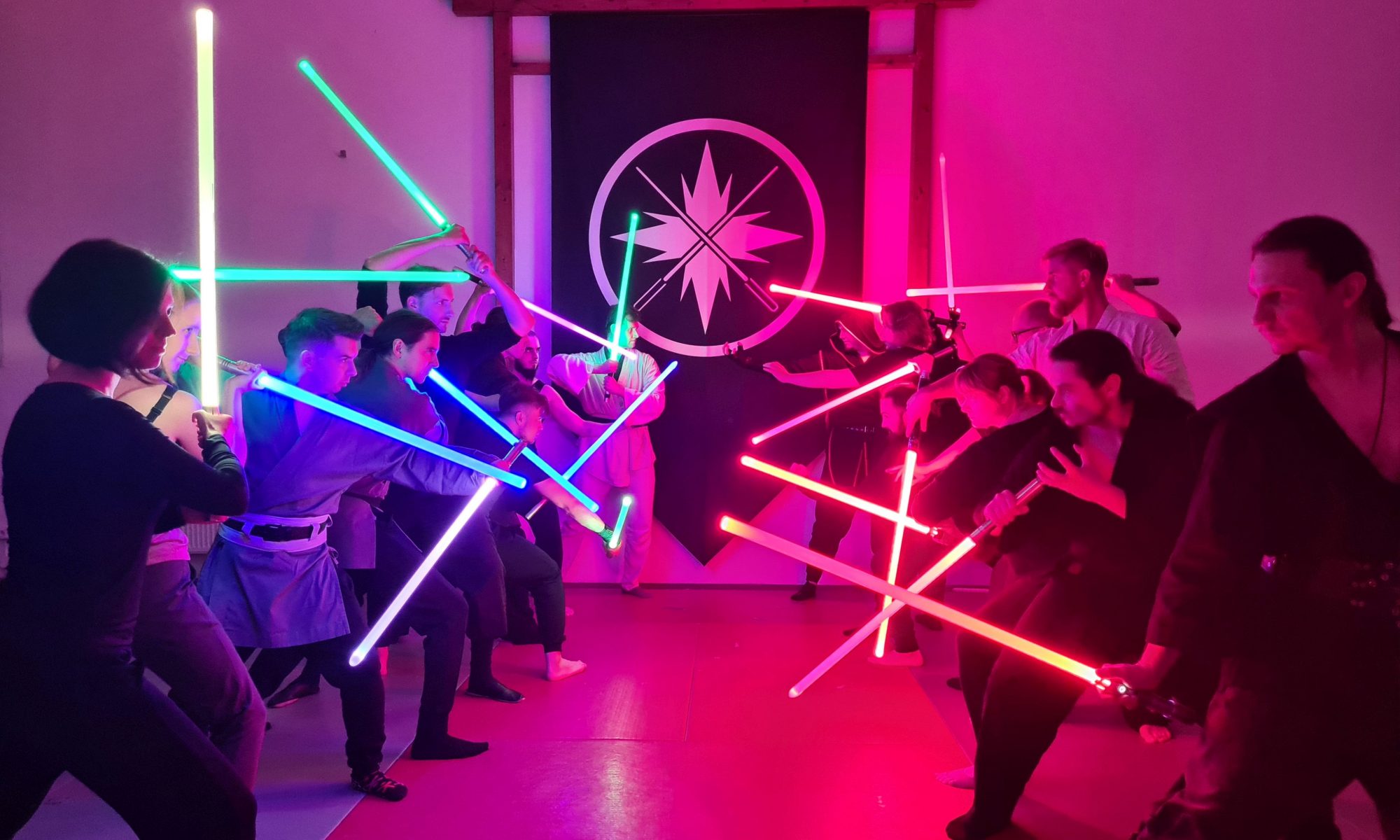IMPROVISED FIGHTING
Improvisations, as we call them, are our most frequent (and most fun) elements of practice. They are a way of fighting focused on safety and showmanship in which the participants are supposed to adapt to each other during the confrontation, and just enjoy the fight.
Improvisations – in contrast to competitive fights – are not scored and there are no winners, hence there are no injuries and no need for heavy protective gear.
Contrary to choreographies, they are not performed from memory according to a previously planned move sequence. Any two (or more) people can enter the fight, have fun and exit unharmed.
Improvisations, therefore, could be compared to a ballroom dance with a changing Leader and Follower.
Below are a number of rules which serve as a base for improvisations:
Safety first
We do not hit each other while improvising. There are no points for it and we fight for fun, excitement and the enjoyment of the spectators. Every blow should be executed with appropriate force and speed, so that it can be stopped, retracted or ‘folded’. We must always control the saber and our surroundings – we mustn’t hit the partner or other people!
Take the initiative
The person who has the initiative ‘leads’ the fight. The Leader decide on the blows’ directions, can spin, turn etc. Improvising isn’t about hitting each other, although aiming for the body usually helps both in defense and in keeping the fight ‘reasonable’. Do not take over the initiative, if your partner is not ready!
Give back the initiative
After a few moves, usually between 4-6, we give the initiative back to the partner. It’s enough to take a clear step back so that the partner notices it and starts attacking. Offer the initiative when your partner makes an uncontrollable move, runs out of space or if you are simply out of ideas 🙂
Be intuitive
While improvising, being predictable is a virtue. If your partner can’t keep up and block your attacks it means that you should slow down or mark your blows more clearly, breaking them apart into 2 pieces – swing and blow. The most intuitive way of doing that is through the initial stance, e.g. sword over your head – vertical blow, sword horizontally at the shoulder – horizontal blow, sword close to the ground – slash at the legs (not going up!).
Adjust the speed
It is especially important if you’re fighting a new partner, possibly less experienced than you. Attack at the speed at which your partner keeps up with correct defenses. If they fall behind, make mistakes or is explicitly afraid to get hit – SLOW DOWN. Adjusting speed is the responsibility of the attacker.
Block, deflect and dodge
Blocking isn’t the only way – it’s a lot easier to avoid the hit by simply moving back. Use other dodges too – below or over the saber – with a jump. Deflecting the weapon is also allowed, although it puts way more force on the saber as well as the partner.
Act out the hits
If you happen to be hit, act it out! Grab the hit location – it will help both the spectators and the partner. Scream or groan in pain! If it’s your leg that got hit act out the pain and start limping. If it’s your primary arm, clutch it. If it’s the stomach, curl up in pain. Don’t use the limb that got hit, act as if you were burnt. You must decide whether the hit was lethal or just a scratch!
Do not make a fuss out of being hit – if you take up a saber you should be ready to accept the risk of an incidental or too strong a hit.
End the fight
Usually a minute or two is enough to have an intense fight and get tired. It is approximately 60 moves per minute. After such time we end the fight – with a hit and ‘acting out the death’ or whatever else could work in the scenario – an escape or a thank you. A polite saber salute is always welcome during training.
The further rules concern more advanced improvisation aspects:
Be spectacular
Improvisations are not competitive fights, therefore we can allow ourselves to do unusual things – body spins, jugglery, saber throws, rolls and anything else we agreed upon with the partner. Note, however, that we shouldn’t spin the saber too much while having initiative as it makes it way harder for the defender to react. The best moment for tricks is when we decide to give up the initiative.
Use the Force 😉
The Star Wars universe lets the combatants use the Force to push, pull, grab or choke the opponent. A well-executed hand gesture should be clear for the partner to act it out accordingly!
Give signals
We compiled a set of signals which let us easily move on to more complicated situations, for example:
– A strong marking of the stance with a ‘shaking’ movement (especially when giving up the initiative) means ‘take advantage of this attack’ – to jump over, roll, play out a previously practiced sequence etc.
– Hitting your fist at your chest means ‘kill me’, with no need for a reason, which allows the partner to break the tempo and decisively strike at the body.
– Displaying the saber diagonally means ‘move into a saber bind’, usually to push at each other or to perform a grappling technique.
Act out a scene
This is a technique for adepts with an acting flair – you can talk during the fight! The partner should react to that, which enables the combatants to build a story around the fight. The simplest examples could be ‘Hello there!’, ‘You betrayed us!’, ‘You’re not getting away this time!’ or ‘Surrender!’.
ADDITIONAL RULES
WEAPONS
The rules of improvising can be applied to any weapon configuration – single saber, twin sabers, saberstaff and all of the other variations.
You needn’t worry about the length of the saber, although it is worthwhile to check the thickness of the blade – the heavy-grade blades might damage the lighter ones.
ONE VERSUS MANY
The simplest technique in a 2 or 3 versus 1 fight is for the attackers to follow the one-attack rule, as then the defender knows exactly whose move to expect next. Once all the attackers step back, the defender may take the initiative. When the ‘single’ has the initiative he or she decides how many attacks to make.
Let yourself be hit if there is more of you – thanks to that the fight balances itself.
BATTLES
These are group fights, from 2v2 up. They usually consist of a charge and a series of 1v1 fights with the emerging winners moving on to next fights, sometimes multiple on one. The battle ends with the last combatant standing 🙂

